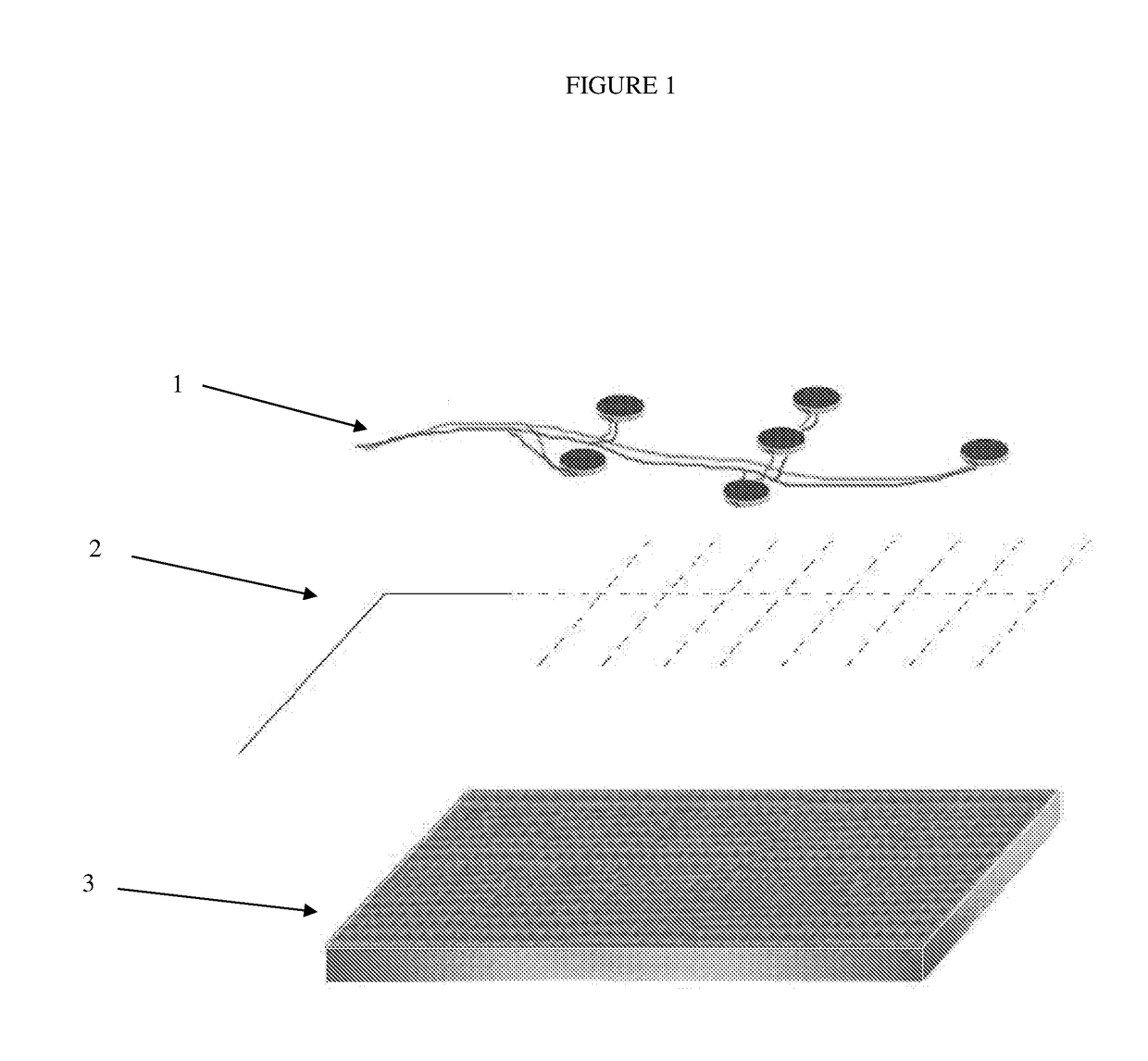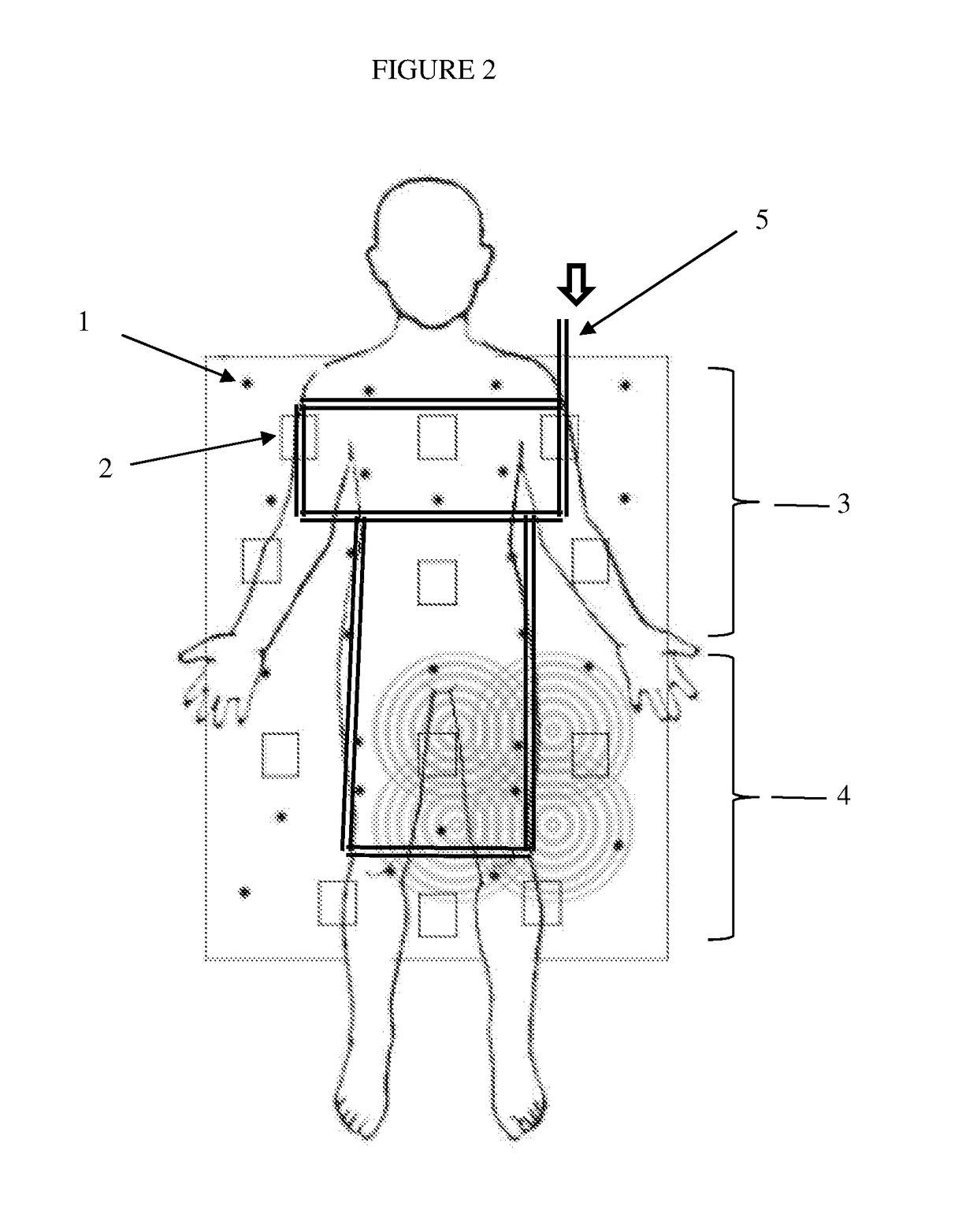Smart bed
a smart bed and bedside technology, applied in the field of smart beds, can solve the problems of decubitus ulcers or bed sores, painful and very slow healing, and difficult to avoid bacterial infections
- Summary
- Abstract
- Description
- Claims
- Application Information
AI Technical Summary
Benefits of technology
Problems solved by technology
Method used
Image
Examples
example 1
Exemplary Design of Smart Sheet Mattress Overlay
[0079]A two-zone mattress overlay is constructed using 27 vibrational motors, 12 pressure sensors and one temperature sensor. FIG. 2 shows the arrangement of the motors and sensors, which lie in a single layer between sheets of fabric. In a second layer, below this first layer, lies the perforated airflow manifold, which is designed as a double-loop arrangement. This arrangement provides effect airflow to all areas of a patient's body. The entire mattress overlay is enclosed in a fabric container which is easily moved from one bed to another, and can also be rolled up for easy storage when not in use. The vibrational motors are medical grade Precision Haptic DC motors operating at 100 Hz frequency.
[0080]Attached via cabling and compressed air hosing to the mattress overlay is the control unit. The control unit is centered on an Arduino Mega 2560 microprocessor, which controls all aspects of the device's operation. The user interface is...
example 2
Effect of Underlying pressure-redistibuting gel layer
[0081]The mattress overlay of Example 1 is operated with a human patient lying in a supine position either with or without an air-permeable, hydrophobic gel layer six-inches in thickness underneath the mattress overlay. The pressure exerted by the patient on the mattress overlay is recorded by nine pressure sensors over a period of about 200 seconds. It is found that in the absence of the gel layer, only 8 of the pressure sensors show a force exerted of under 5 Newtons. One sensor, however, consistently shows a force exerted of from 10 to 45 Newtons. This is considerably higher than is desirable, and would suggest a higher risk of bed sore development for a patient lying supine on such a mattress. In contrast, when the mattress overlay is used on top of the hydrophobic gel, sensor 8 shows a consistent force exerted of only about 8 Newtons, while the remaining sensors all register below 5 Newtons. This demonstrates that the gel lay...
example 3
Effect of Airflow Manifold
[0082]The design of Example 1 utilizes a double-rectangular loop airflow manifold as shown in FIG. 2. Perforations are placed around the length of the tubing (diameter ¼ inch) approximately every five inches. Compressed air is supplied at a pressure of 60 psi, and the airflow was turned on for two-minute intervals every sixteen minutes, while temperature was recorded at five second intervals. Temperature was measured at the single sensor under the center of the patient's body. The patient did not substantially move for the duration of the 30 minute test. The results demonstrate that absent airflow, the temperature sensor gradually recorded higher temperature as heat and moisture accumulated between the patient's body and the mattress overlay. In contrast, with the intermittent running of the airflow manifold, the temperature sensor's recorded temperature remained approximately constant.
PUM
 Login to View More
Login to View More Abstract
Description
Claims
Application Information
 Login to View More
Login to View More - R&D
- Intellectual Property
- Life Sciences
- Materials
- Tech Scout
- Unparalleled Data Quality
- Higher Quality Content
- 60% Fewer Hallucinations
Browse by: Latest US Patents, China's latest patents, Technical Efficacy Thesaurus, Application Domain, Technology Topic, Popular Technical Reports.
© 2025 PatSnap. All rights reserved.Legal|Privacy policy|Modern Slavery Act Transparency Statement|Sitemap|About US| Contact US: help@patsnap.com


